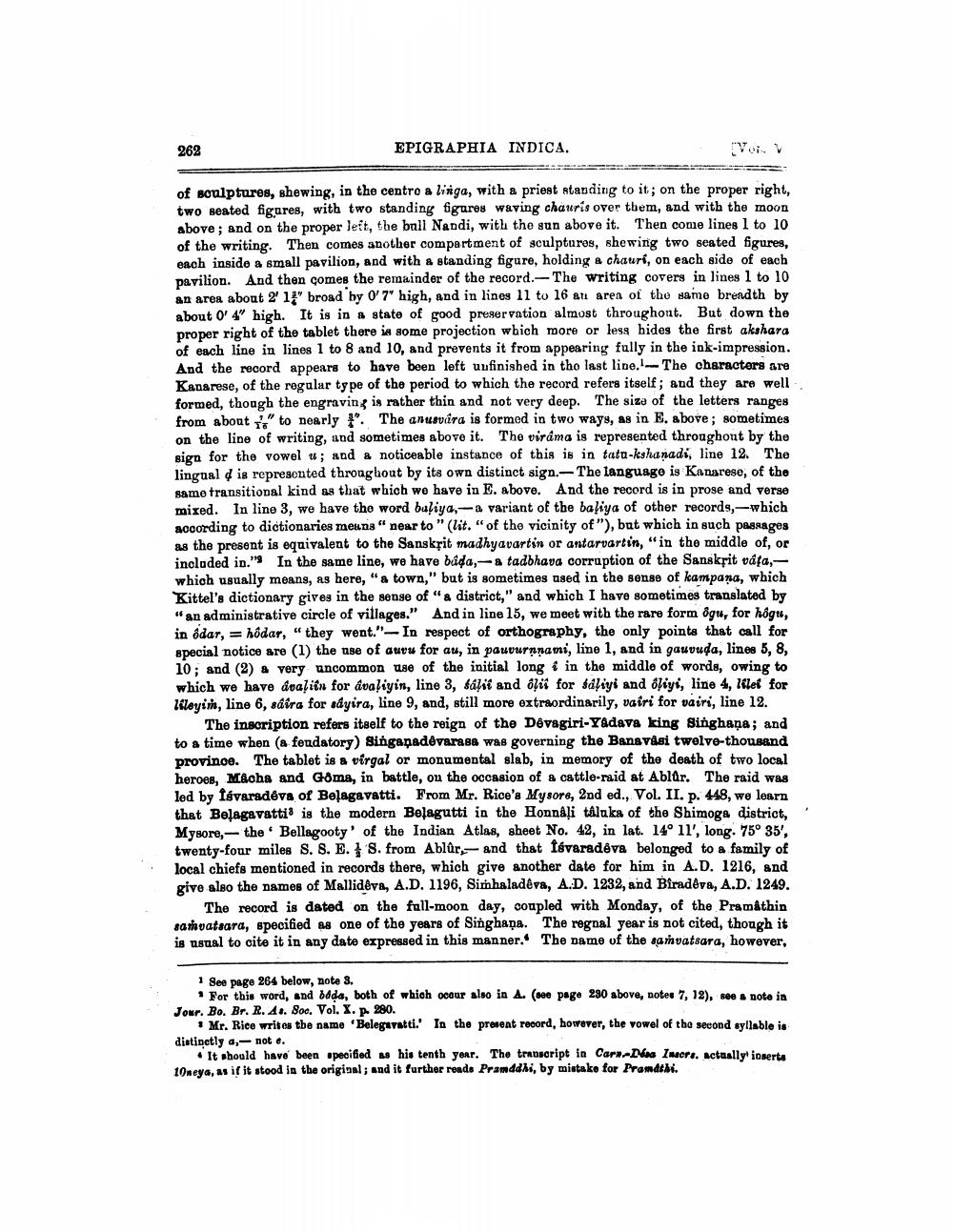________________
262
EPIGRAPHIA INDICA.
Vei.
of soulptures, shewing, in the centro a linga, with a priest standing to it; on the proper right, two seated figures, with two standing figures waving chauris over them, and with the moon above ; and on the proper left, the ball Nandi, with the sun above it. Then come lines 1 to 10 of the writing. Then comes another compartment of sculptures, shewing two seated figures, each inside a small pavilion, and with a standing figure, holding a chauri, on each side of each pavilion. And then comes the remainder of the record. The writing covers in lines 1 to 10 an area about 2' 14" broad by 0'7" high, and in lines 11 to 16 an area of the same brendth by about O' 4" high. It is in a state of good preservation almost throughont. But down the proper right of the tablet there is some projection which more or less hides the first akshara of each line in lines 1 to 8 and 10, and prevents it from appearing fully in the ink-impression. And the record appears to have been left unfinished in tho last line. The characters are Kanarese, of the regalar type of the period to which the record refers itself; and they are well formed, though the engraving is rather thin and not very deep. The size of the letters ranges from about 1" to nearly *". The anusvira is formed in two ways, as in E. above; sometimes on the line of writing, and sometimes above it. The virama is represented throughont by the sign for the vowel ; and a noticeable instance of this is in tata-kshanadi, line 12. The lingual d is represented throughout by its own distinct sign. The language is Kanarese, of the same transitional kind as that which we have in E. above. And the record is in prose and verse mixed. In line 3, we have the word buļiya,-a variant of the basiya of other records, which according to dictionaries means "near to " (lit. "of the vicinity of "), but which in such passages as the present is equivalent to the Sanskpit madhyavartin or antarvartin, "in the middle of, or included in." In the same line, we have báda,-a tadbhava corruption of the Sanskrit váta, - which usually means, as here, "a town," but is sometimes used in the sense of kampana, which Kittels dictionary gives in the sense of "& district," and which I have sometimes translated by "an administrative circle of villages." And in line 15, we meet with the rare form ogu, for hôgu, in ôdar, = hôdar, “they went." In respect of orthography, the only points that call for special notice are (1) the use of auru for au, in pauvurnnani, line 1, and in gauvuda, lines 5, 8, 10; and (2) & very uncommon use of the initial long in the middle of words, owing to which we have coalitn for avaliyin, line 3, táļi and olii for $áliyi and bliyi, line 4, ifle for Isleyim, line 6, sáira for sdyira, line 9, and, still more extraordinarily, vairi for vairi, line 12.
The inscription refers itself to the reign of the Devagiri-Yadava king singhaņa; and to a time when (& fendatory) Singapadêvarasa was governing the Banavasi twelve-thousand province. The tablet is a virgal or monumental slab, in memory of the death of two local heroes, Macha and Goma, in battle, on the occasion of a cattle-raid at Ablar. The raid was led by Isvaradeva of Belagavatti. From Mr. Rice's Mysore, 2nd ed., VOL. II. p. 448, we learn that Bolagavattis is the modern Belagutti in the Honnali taluks of the Shimoga district, Mysore, -the Bellagooty' of the Indian Atlas, sheet No. 42, in lat. 14° 11', long. 75° 35', twenty-four miles S. 8. E. S. from Ablûr, and that tsvaradeva belonged to a family of local chiefs mentioned in records there, which give another date for him in A.D. 1216, and give also the names of Mallidêya, A.D. 1196, Simhaladêva, A.D. 1232, and Biradova, A.D. 1249.
The record is dated on the full-moon day, coupled with Monday, of the Pramåthin samvatsara, specified as one of the years of Singhana. The regnal year is not cited, though it is usual to cite it in any date expressed in this manner. The name of the samvatsara, however,
1 See page 264 below, note 3.
* For this word, and odda, both of which occur also in A. (sve page 280 above, note 7, 12), 16 note in Jour. Bo. Br. R. As. Soc. Vol. X. p. 280.
• Mr. Rico writes the name 'Beleguvatti. In the present record, however, the vowel of the second syllable is distinctly a,- not e.
It should have been specified as his tenth year. The transcript in Carr-Dies Imeri. Actually inserts 10neya, m if it stood in the original; and it further reads Pramddhi, by mistake for Pramdeki.




